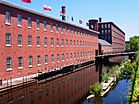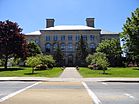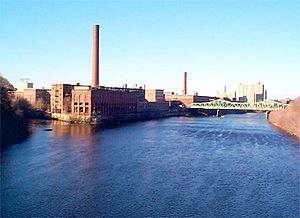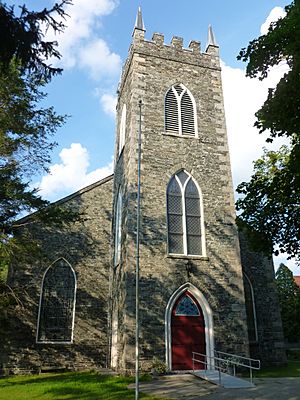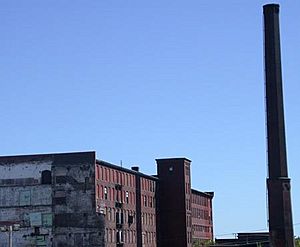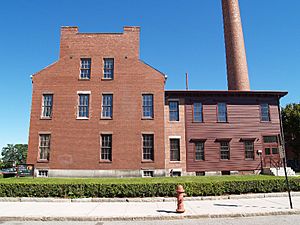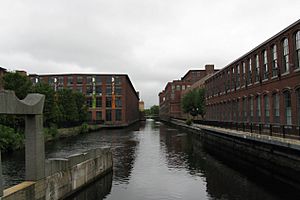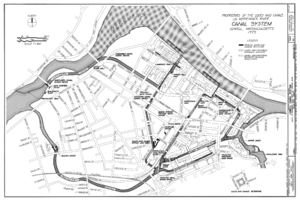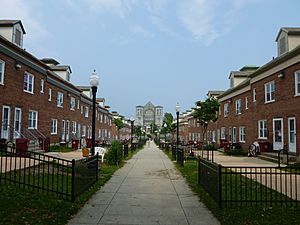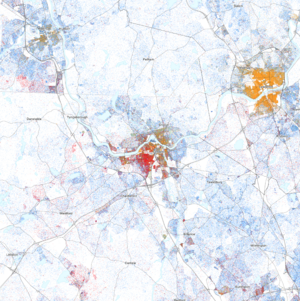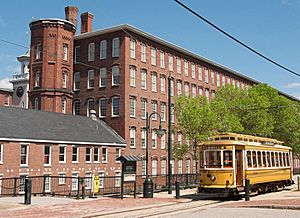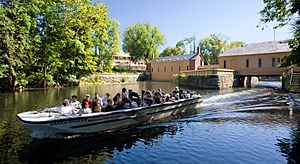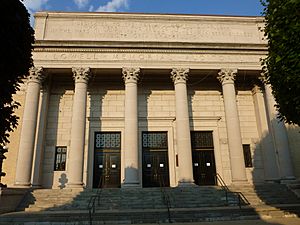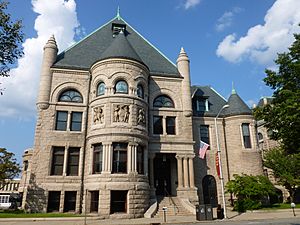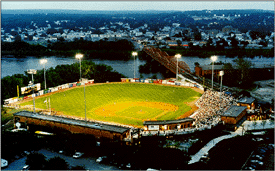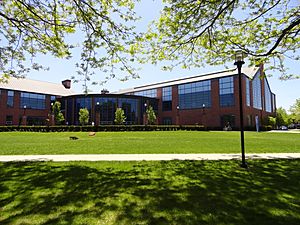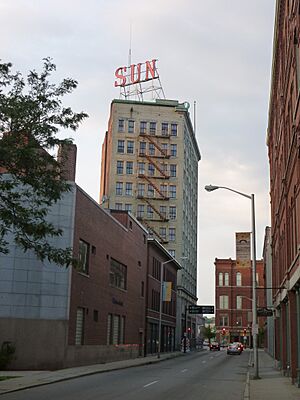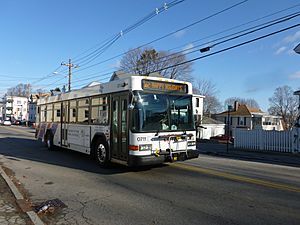Lowell, Massachusetts facts for kids
Quick facts for kids
Lowell, Massachusetts
|
|||
|---|---|---|---|
|
Left-right from top: Lowell City Hall, Lowell mills, University of Massachusetts Lowell, Lowell Skyline
|
|||
|
|||
| Nickname(s):
Mill City, Spindle City, City of Lights City of Magic
|
|||
| Motto(s):
"Art is the Handmaid of Human Good."
|
|||
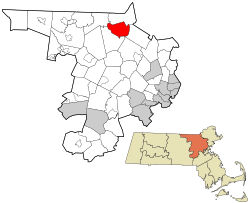
Location in Middlesex County in Massachusetts
|
|||
| Country | United States | ||
| State | Massachusetts | ||
| County | Middlesex | ||
| Region | New England | ||
| Settled | 1652 | ||
| Incorporated | 1826 | ||
| A city | 1836 | ||
| Named for | Francis Cabot Lowell | ||
| Government | |||
| • Type | Manager-City council | ||
| Area | |||
| • Total | 14.53 sq mi (37.63 km2) | ||
| • Land | 13.61 sq mi (35.25 km2) | ||
| • Water | 0.92 sq mi (2.38 km2) | ||
| Elevation | 102 ft (31 m) | ||
| Population
(2020)
|
|||
| • Total | 115,554 | ||
| • Density | 8,489.75/sq mi (3,278.02/km2) | ||
| • Demonym | Lowellian | ||
| Time zone | UTC−5 (Eastern) | ||
| • Summer (DST) | UTC−4 (Eastern) | ||
| ZIP code |
01850, 01851, 01852, 01853, 01854
|
||
| Area code(s) | 978 / 351 | ||
| FIPS code | 25-37000 | ||
| GNIS feature ID | 0611832 | ||
Lowell is a city in Massachusetts, United States. It's one of the two main cities in Middlesex County. In 2020, about 115,554 people lived there. This makes it the fifth largest city in Massachusetts. Lowell is also part of the bigger Boston area.
Lowell was started in 1826 as a mill town. It was named after Francis Cabot Lowell, a key person in the Industrial Revolution. The city became famous as the birthplace of the American Industrial Revolution. This was because of its many textile mills and factories. Today, many of these old factory sites are part of the Lowell National Historical Park. After the Cambodian genocide (1975–1979), many refugees came to Lowell. This led to a special Cambodia Town and the second-largest Cambodian-American community in the U.S.
Lowell has two important colleges. UMass Lowell, part of the University of Massachusetts system, has three campuses here. Middlesex Community College also has campuses in Lowell. For arts, you can visit the Whistler House Museum of Art or watch shows at the Merrimack Repertory Theatre. The city is also known for boxing, hosting the yearly New England Golden Gloves tournament. Lowell has a baseball stadium, Edward A. LeLacheur Park, and an indoor sports arena, the Tsongas Center.
Contents
- Lowell's Story: A City's Journey
- Lowell's Location and Climate
- Who Lives in Lowell?
- Fun Things to Do in Lowell
- Sports in Lowell
- Parks and Recreation Spots
- Learning in Lowell
- News and Media
- Getting Around Lowell
- Famous People from Lowell
- Cool Inventions and Businesses from Lowell
- Lowell's Sister Cities
- Awards and Recognition
- Images for kids
- See also
Lowell's Story: A City's Journey
Lowell has a rich and interesting history. It started as a small community and grew into a major industrial city.
Early Days: Native People and Settlers
The Pawtucket Falls were very important. Native people used them for fishing long before Europeans arrived. The Pawtucket tribe got its name from this place, meaning "at the falls." In the 1600s, English settlers tried to convert native people to Christianity. They created "praying towns" like Wamesit in what is now Lowell. By the 1800s, this area was a farming community called East Chelmsford.
How Lowell Became a Mill Town
Lowell was planned in the 1820s to be a big manufacturing center for textiles. It was built along the fast-flowing Merrimack River, about 25 miles northwest of Boston. A group called the Boston Associates named the new town after Francis Cabot Lowell. He was a leader in the textile industry who had passed away.
As Lowell grew, it took land from nearby towns. It became a busy city. Many workers who built the canals and factories came from Ireland. They were escaping poverty and the Great Famine. The mill workers were often young, single women called Mill Girls. They usually came from New England farm families.
By the 1850s, Lowell had the largest industrial area in the United States. Its textile factories used cotton from the Southern U.S. In 1860, Lowell had more cotton spindles than all eleven states that would later form the Confederacy. Many of the rough cotton fabrics made in Lowell were sent back to the South to make clothes.
The city continued to grow in the 19th century. More workers and immigrants came to its mills. First came Catholic Germans, then many French Canadians in the 1870s and 1880s. Later, other immigrant groups arrived and settled in different neighborhoods. By 1900, almost half of Lowell's population was born outside the U.S. The city's economy was at its strongest when World War I began.
Changes and Challenges
After the 1920s, many factories started moving away from Lowell. The city faced tough times. In 1931, a magazine even called it a "depressed industrial desert." This was during the Great Depression. More than a third of the people in Lowell needed government help. Only three major textile companies were still open.
A few years later, the mills reopened to make things for World War II, like parachutes. But this boost didn't last. After the war, the last textile factories closed.
Lowell's Comeback: A New Focus
In the 1970s, Lowell started to recover. It became the home of Wang Laboratories, a big computer company. At the same time, thousands of new immigrants arrived, many from Cambodia. The city began to focus more on culture. The old mill area along the river was partly fixed up. It became part of the Lowell National Historical Park in the late 1970s.
Even though Wang Laboratories went out of business in 1992, Lowell kept its focus on culture. It hosts the Lowell Folk Festival, a large free festival. This helped bring new companies and families back to the city. Old factory buildings were turned into homes and offices. By the 1990s, Lowell had new sports venues. The University of Massachusetts Lowell and Middlesex Community College also grew.
The city also updated its rules for building and land use. This helped make sure new buildings fit in with the city's character. The Hamilton Canal District is a big project. It's turning empty land into a new neighborhood with homes, shops, and offices.
Lowell's Location and Climate
Lowell is located where the Merrimack and Concord rivers meet. This spot is at 42.639444 degrees North and -71.314722 degrees West. The city covers about 14.5 square miles. Most of this is land, with about 0.8 square miles of water.
Weather in Lowell
Lowell has four seasons. Winters are long and very cold, with about 56 inches of snow each year. The most snow ever recorded was 120 inches in one winter! Summers are hot and humid. Spring and autumn are short periods between winter and summer. Temperatures in summer usually range from 64 to 84 degrees Fahrenheit. In winter, they are between 2 and 33 degrees Fahrenheit. The average yearly temperature is 49 degrees Fahrenheit.
| Climate data for Lowell, Massachusetts (1991–2020 normals, extremes 1885–present) | |||||||||||||
|---|---|---|---|---|---|---|---|---|---|---|---|---|---|
| Month | Jan | Feb | Mar | Apr | May | Jun | Jul | Aug | Sep | Oct | Nov | Dec | Year |
| Record high °F (°C) | 70 (21) |
77 (25) |
89 (32) |
96 (36) |
98 (37) |
102 (39) |
103 (39) |
103 (39) |
100 (38) |
89 (32) |
81 (27) |
76 (24) |
103 (39) |
| Mean maximum °F (°C) | 56.1 (13.4) |
58.0 (14.4) |
68.3 (20.2) |
82.9 (28.3) |
90.2 (32.3) |
94.1 (34.5) |
95.5 (35.3) |
93.8 (34.3) |
90.0 (32.2) |
79.8 (26.6) |
69.9 (21.1) |
60.1 (15.6) |
97.5 (36.4) |
| Mean daily maximum °F (°C) | 34.0 (1.1) |
37.3 (2.9) |
45.4 (7.4) |
59.0 (15.0) |
70.0 (21.1) |
79.0 (26.1) |
84.7 (29.3) |
83.0 (28.3) |
75.5 (24.2) |
62.4 (16.9) |
50.5 (10.3) |
39.8 (4.3) |
60.0 (15.6) |
| Daily mean °F (°C) | 24.9 (−3.9) |
27.1 (−2.7) |
34.9 (1.6) |
46.8 (8.2) |
57.5 (14.2) |
67.0 (19.4) |
72.8 (22.7) |
71.1 (21.7) |
63.5 (17.5) |
50.9 (10.5) |
40.4 (4.7) |
31.0 (−0.6) |
49.0 (9.4) |
| Mean daily minimum °F (°C) | 15.8 (−9.0) |
16.9 (−8.4) |
24.4 (−4.2) |
34.6 (1.4) |
45.0 (7.2) |
55.0 (12.8) |
60.9 (16.1) |
59.3 (15.2) |
51.5 (10.8) |
39.5 (4.2) |
30.3 (−0.9) |
22.1 (−5.5) |
37.9 (3.3) |
| Mean minimum °F (°C) | −2.4 (−19.1) |
0.7 (−17.4) |
8.2 (−13.2) |
23.9 (−4.5) |
33.4 (0.8) |
43.3 (6.3) |
51.9 (11.1) |
49.8 (9.9) |
37.6 (3.1) |
26.5 (−3.1) |
17.0 (−8.3) |
5.8 (−14.6) |
−5.0 (−20.6) |
| Record low °F (°C) | −22 (−30) |
−29 (−34) |
−14 (−26) |
6 (−14) |
27 (−3) |
33 (1) |
44 (7) |
38 (3) |
26 (−3) |
19 (−7) |
1 (−17) |
−20 (−29) |
−29 (−34) |
| Average precipitation inches (mm) | 3.61 (92) |
3.20 (81) |
4.32 (110) |
4.06 (103) |
3.81 (97) |
4.37 (111) |
3.86 (98) |
4.00 (102) |
3.89 (99) |
5.00 (127) |
3.85 (98) |
4.54 (115) |
48.51 (1,233) |
| Average snowfall inches (cm) | 15.9 (40) |
14.2 (36) |
11.2 (28) |
1.9 (4.8) |
0.0 (0.0) |
0.0 (0.0) |
0.0 (0.0) |
0.0 (0.0) |
0.0 (0.0) |
0.0 (0.0) |
1.5 (3.8) |
11.4 (29) |
56.1 (141.6) |
| Average extreme snow depth inches (cm) | 10.7 (27) |
11.2 (28) |
9.8 (25) |
1.3 (3.3) |
0.0 (0.0) |
0.0 (0.0) |
0.0 (0.0) |
0.0 (0.0) |
0.0 (0.0) |
0.1 (0.25) |
1.2 (3.0) |
8.0 (20) |
17.5 (44) |
| Average precipitation days (≥ 0.01 in) | 10.9 | 9.2 | 10.6 | 11.2 | 12.7 | 11.3 | 10.4 | 9.7 | 9.2 | 10.9 | 10.5 | 10.7 | 127.3 |
| Average snowy days (≥ 0.1 in) | 6.3 | 5.2 | 3.6 | 0.8 | 0.0 | 0.0 | 0.0 | 0.0 | 0.0 | 0.1 | 1.0 | 3.8 | 20.8 |
| Source 1: NOAA | |||||||||||||
| Source 2: National Weather Service | |||||||||||||
Rivers and Hills
Lowell is at the meeting point of the Merrimack and Concord rivers. The Pawtucket Falls are a mile-long series of rapids. They drop 32 feet where the two rivers meet. A dam at the top of the falls helps direct water into Lowell's many canals.
The Merrimack River flows south from New Hampshire to Lowell. Then it turns northeast and flows into the Atlantic Ocean. This is about 40 miles from Lowell. Long ago, the Merrimack might have flowed south to Boston. The hills in Lowell, like Fort Hill, were formed by glaciers.
The Concord River flows north into Lowell. It has many waterfalls and rapids. These were used for power even before Lowell was founded. Just after the Concord joins the Merrimack, the Merrimack drops another ten feet at Hunt's Falls.
Lowell's Neighborhoods
Lowell has eight main neighborhoods. These are the Acre, Back Central, Belvidere, Centralville, Downtown, Highlands, Pawtucketville, and South Lowell. Each has its own unique feel.
- Centralville is in the northeast, north of the Merrimack River.
- The Highlands is the largest neighborhood, in the southwest. It's home to almost a quarter of the city's people.
- Downtown, Belvidere, Back Central, and South Lowell are in the southeast. Belvidere is mostly homes. Downtown Lowell has parts of UMass Lowell and Middlesex Community College.
- Pawtucketville is in the northwest. It includes the University of Massachusetts Lowell, North Campus. This area was once home to a Native American tribe.
Who Lives in Lowell?
| Historical population | ||
|---|---|---|
| Year | Pop. | ±% |
| 1830 | 6,474 | — |
| 1840 | 20,796 | +221.2% |
| 1850 | 33,383 | +60.5% |
| 1860 | 36,827 | +10.3% |
| 1870 | 40,928 | +11.1% |
| 1880 | 59,475 | +45.3% |
| 1890 | 77,696 | +30.6% |
| 1900 | 94,969 | +22.2% |
| 1910 | 106,294 | +11.9% |
| 1920 | 112,759 | +6.1% |
| 1930 | 100,234 | −11.1% |
| 1940 | 101,389 | +1.2% |
| 1950 | 97,249 | −4.1% |
| 1960 | 92,107 | −5.3% |
| 1970 | 94,239 | +2.3% |
| 1980 | 92,418 | −1.9% |
| 1990 | 103,439 | +11.9% |
| 2000 | 105,167 | +1.7% |
| 2010 | 106,519 | +1.3% |
| 2020 | 115,554 | +8.5% |
| 2022* | 113,608 | −1.7% |
| * = population estimate. Source: United States Census records and Population Estimates Program data. Source: |
||
Lowell is a diverse city with people from many different backgrounds.
Lowell's Population in 2020
In 2020, Lowell had 115,554 people. The city is very diverse.
| Race / Ethnicity (NH = Non-Hispanic) | Pop 2000 | Pop 2010 | Pop 2020 | % 2000 | % 2010 | % 2020 |
|---|---|---|---|---|---|---|
| White (NH) | 65,760 | 56,280 | 46,908 | 62.53% | 52.84% | 40.59% |
| Black or African American (NH) | 3,644 | 6,367 | 9,570 | 3.46% | 5.98% | 8.28% |
| Native American or Alaska Native (NH) | 170 | 137 | 111 | 0.16% | 0.13% | 0.10% |
| Asian (NH) | 17,302 | 21,337 | 25,548 | 16.45% | 20.03% | 22.11% |
| Pacific Islander or Native Hawaiian (NH) | 12 | 34 | 56 | 0.01% | 0.03% | 0.05% |
| Some other race (NH) | 474 | 1,554 | 2,494 | 0.45% | 1.46% | 2.16% |
| Mixed race or Multiracial (NH) | 3,071 | 2,414 | 5,816 | 2.92% | 2.27% | 5.03% |
| Hispanic or Latino (any race) | 14,734 | 18,396 | 25,051 | 14.01% | 17.27% | 21.68% |
| Total | 105,167 | 106,519 | 115,554 | 100.00% | 100.00% | 100.00% |
In 2010, Lowell had about 7,842 people per square mile. There were 41,431 homes. The average household had 2.66 people, and families had 3.31 people. About 34.9% of homes had children under 18.
The average age in Lowell in 2010 was 32.6 years old. About 23.7% of the population was under 18. Also, 10.1% were 65 or older.
The median income for a household in 2012 was $51,714. For families, it was $55,852. About 17.5% of individuals lived below the poverty line. This included 24.5% of those under 18.
Cambodian-American Community
Lowell has the largest percentage of people of Cambodian origin in the United States. In 2010, 12.5% of the population was Cambodian. The Cambodian government even has a Consular Office in Lowell. In 2022, Lowell elected Sokhary Chau, the first Cambodian-American mayor in the U.S.
Fun Things to Do in Lowell
Yearly Events
Lowell hosts many exciting events throughout the year:
- February: Winterfest – A winter celebration. It's also Lowell's birthday!
- March: Lowell Women's Week – Honors women's achievements. Irish Cultural Week – Celebrates Irish history and culture.
- April: Lowell Film Festival – Shows movies about topics important to the community.
- May: Doors Open Lowell – Historic buildings open for public viewing.
- June: African Festival – Celebrates African communities in Lowell.
- July: Lowell Folk Festival – A huge, free music and arts festival. About 250,000 people attend.
- August: Lowell Southeast Asian Water Festival – Celebrates Southeast Asian culture.
- September: Lowell Kinetic Sculpture Race – A fun race with amazing homemade machines.
- October: Lowell Celebrates Kerouac Festival – Honors writer Jack Kerouac and his connection to Lowell.
- October: Bay State Marathon – A marathon and half marathon race.
Places to Visit
Lowell has 39 places listed on the National Register of Historic Places. Many are part of the Lowell National Historical Park.
- Lowell National Historical Park: Learn about Lowell's past as a factory city. See old weave rooms and canals.
- Lowell-Dracut-Tyngsboro State Forest: Great for hiking, biking, and cross-country skiing.
- University of Massachusetts Lowell: A large state university.
- Vandenberg Esplanade: A park along the Merrimack River for walking, biking, and picnics. It has the Sampas Pavilion.
- Western Avenue Studios: One of the largest groups of artist studios in the U.S.
- Jack Kerouac's Birthplace: The home where the famous writer was born.
- Armenian genocide Memorial: "A Mother's Hands" monument at Lowell City Hall.
- Bette Davis's Birthplace: The home where the famous actress was born.
- Lowell Cemetery: The burial place of many important people from Lowell's past.
- Edson Cemetery: Where Jack Kerouac is buried. It also has a monument to Chief Passaconaway.
- The Acre: A historic neighborhood where many immigrants have settled.
- Little Cambodia: An area the city is developing for tourists to experience Cambodian culture.
Lowell's Culture and Arts
Lowell has been a center for culture since the 1840s. It had the Lowell Museum and Mechanics Hall. Today, Lowell offers many art shows and performances.
Museums and Galleries
- The Boott Cotton Mills Museum: Part of the Lowell National Historic Park.
- Mill No. 5: A unique indoor market with handmade items, music, and an independent movie theater.
- The New England Quilt Museum: Features beautiful quilts.
- Whistler House Museum of Art: An art museum in the birthplace of artist James McNeill Whistler.
- Western Avenue Studios: A converted mill with over 300 artists and musicians.
Live Performances
- Angkor Dance Troupe: A Cambodian classical and folk dance group.
- Lowell Memorial Auditorium: A place for live shows.
- The Lowell Chamber Orchestra: Lowell's first professional orchestra.
- Lowell Summer Music Series: Concerts held outdoors at Boarding House Park.
- Merrimack Repertory Theater: A professional theater company.
- Sampas Pavilion: An outdoor stage by the Merrimack River.
Libraries in Lowell
Lowell has several libraries for learning and research.
Pollard Memorial Library
This is Lowell's main public library. It started in 1844. The current building was built in 1890-1891. It was named "Memorial Hall" to honor soldiers from the Civil War. In 1981, it was renamed the Pollard Memorial Library. The library has about 236,000 books.
University Libraries
- Lydon Library: Located at University of Massachusetts Lowell North Campus. It focuses on science, engineering, and business.
- O'Leary Library: Located at University of Massachusetts Lowell South Campus. It focuses on music and art.
- Center for Lowell History: Part of University of Massachusetts Lowell. It collects and preserves materials about Lowell's history. This includes information on factories, immigration, and social life.
Sports in Lowell
Boxing History
Boxing is a big part of Lowell's working-class culture. The city's auditorium hosts the yearly New England Golden Gloves tournament. Famous boxers like Rocky Marciano and Sugar Ray Leonard have fought there. Local boxers Micky Ward and Dicky Eklund started their careers in Lowell. Their story was even made into a movie called The Fighter.
Local Sports Teams
- University of Massachusetts Lowell River Hawks: Play in NCAA Division I for hockey, soccer, basketball, and more.
- Lowell Spinners: Were a professional minor league baseball team.
- Boston Fleet: A professional women's ice hockey team.
- Lowell All-Americans: A college summer baseball team.
- Lowell Nor'easter: A semi-professional football team.
- Greater Lowell United FC: A semi-professional soccer team.
Parks and Recreation Spots
Sports Venues
- Edward A. LeLacheur Park: A baseball stadium owned by University of Massachusetts Lowell.
- Lowell Memorial Auditorium: Used for performances and boxing matches.
- Tsongas Center at UMass Lowell: A large venue for sports and concerts. It seats 6,500 for hockey and 7,800 for concerts.
- Cawley Memorial Stadium: The stadium for Lowell High School sports.
- Stoklosa Alumni Field: A baseball stadium with 4,000 seats.
- Costello Athletic Center: An indoor arena at University of Massachusetts Lowell.
- UMass Lowell Bellgarde Boathouse: A center for rowing and kayaking.
- Long Meadow Golf Club: A private 9-hole golf course.
- Mount Pleasant Golf Club: Another private 9-hole golf course.
Learning in Lowell
Colleges and Universities
Lowell is becoming a big college town. It has over 31,000 students!
- Middlesex Community College: The second largest community college in Massachusetts.
- University of Massachusetts Lowell: The third largest state university in Massachusetts. It has top research labs.
Schools for Kids
Lowell Public Schools runs the public schools in the city.
- Lowell High School: The main public high school.
- Other public schools include Greater Lowell Technical High School and several charter schools.
Lowell Public Schools is an above-average school district. It has about 14,247 students from Pre-K to 12th grade. There are 14 students for every teacher. At Lowell High School, students can take advanced classes. About 68% of students are from minority groups.
News and Media
Newspapers
The Sun is Lowell's main daily newspaper. It covers news for the Greater Lowell area. In 2011, it printed about 42,900 copies each day.
Radio Stations
- WCAP AM 980: A talk radio station.
- WLLH AM 1400: Plays Spanish Tropical music.
- WUML FM 91.5: A station owned by UMass Lowell.
- WCRB FM 99.5: Plays classical music.
Getting Around Lowell
Transportation Options
You can reach Lowell by car using major highways like Interstate 495 and U.S. Route 3. Several state routes also go through the city. Lowell has six bridges crossing the Merrimack River.
For public transport, the Lowell Regional Transit Authority (LRTA) runs bus services. You can also take the MBTA commuter rail Lowell Line to Boston's North Station.
The Lowell National Historical Park offers a free streetcar to different sites downtown.
Hospitals in Lowell
- Lowell General Hospital
- Saints Medical Center
Law Enforcement
The city is mainly protected by the Lowell Police Department. The UMass Lowell also has its own police. The Massachusetts State Police help with safety too.
Famous People from Lowell
- See List of people from Lowell, Massachusetts
Cool Inventions and Businesses from Lowell
Current Innovations
- Massachusetts Medical Device Development Center (M2D2): A lab that helps create new medical devices.
- UMASS Lowell Innovation Hub (iHUB): A place for new businesses and startups to get started. It offers office space and tools for making prototypes.
Historical Inventions and Businesses
- Cash Carriers: A system for moving cash in stores, patented in Lowell in 1881.
- CVS/pharmacy: Started in Lowell in 1963 as the Consumer Value Store.
- Father John's Medicine: A cough medicine first made in a Lowell pharmacy in 1855.
- Francis Turbine: A very efficient water-powered turbine.
- Market Basket: A chain of grocery stores that started here.
- Moxie: The first mass-produced soft drink in the U.S.
- Prince Spaghetti: Once a major pasta maker. Their Lowell plant was the largest in the country.
- Telephone Numbers: Lowell was the first U.S. city to use phone numbers in 1879.
- Wang Laboratories: A big computer company that was part of the "Massachusetts Miracle."
Banks and Financial Institutions
- Lowell Five Cent Savings Bank: Founded in 1854, it was the first bank in Lowell to accept small deposits. It's one of the oldest banks in America.
- Washington Savings Bank: Started in Lowell in 1892.
- Enterprise Bank and Trust: Founded in Lowell in 1989.
- Jeanne D'Arc Credit Union: Started in 1911, it's one of the largest credit unions in Massachusetts.
Lowell's Sister Cities
Lowell has "sister cities" around the world. These partnerships help promote cultural exchange and understanding.
 Bamenda, Cameroon (2002)
Bamenda, Cameroon (2002) Barclayville, Liberia
Barclayville, Liberia Berdyansk, Ukraine (1997)
Berdyansk, Ukraine (1997) Kalamata, Greece (2020)
Kalamata, Greece (2020) Nairobi, Kenya
Nairobi, Kenya Limerick, Ireland (2013)
Limerick, Ireland (2013) Lobito, Angola
Lobito, Angola Phnom Penh, Cambodia (2015)
Phnom Penh, Cambodia (2015) Saint-Dié-des-Vosges, France (1989)
Saint-Dié-des-Vosges, France (1989) Winneba, Ghana (2010)
Winneba, Ghana (2010)
Awards and Recognition
- 2010: Lowell was named a "Green Community."
- 1999: Lowell received an All-America City award. It was also a finalist in 1997 and 1998.
Images for kids
See also
 In Spanish: Lowell (Massachusetts) para niños
In Spanish: Lowell (Massachusetts) para niños



